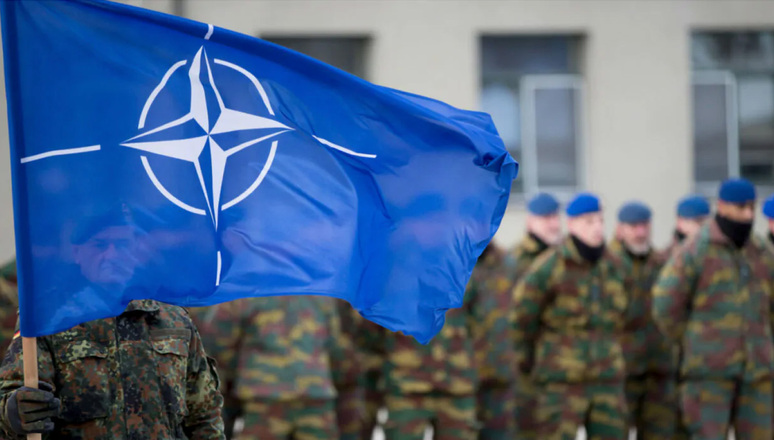NATO Force Model
- English
- French
The NATO Force Model is a framework through which the Alliance organises, manages, activates and commands Allied national forces in support of NATO’s three core tasks: deterrence and defence, crisis prevention and management, and cooperative security. It enables a more proactive NATO force posture by increasing responsiveness, readiness and combat power.

A German soldier holds the NATO flag at the Alliance’s multinational battlegroup in Rukla, Lithuania. © Kay Nietfeld / dpa picture alliance
- The NATO Force Model provides the overarching framework for making national forces available to the Alliance. It gives NATO’s political and military leaders a more systematic and comprehensive overview of all of the national forces that can be made available in peacetime, crisis and conflict in support of NATO’s three core tasks, including for collective defence.
- The Model replaces the NATO Response Force (NRF) as the main organising framework of NATO’s multinational forces.
- Compared to the NRF, the Model has more than tripled the number of high-readiness forces potentially available to NATO, increasing the Alliance’s ability to respond to a crisis or conflict at greater scale and at higher readiness.
- The Allied Reaction Force (ARF) is a component of the NATO Force Model. A high-readiness, multinational and multi-domain force, the ARF can be deployed rapidly to carry out the Alliance’s full spectrum of missions.
How does the NATO Force Model work?
Under the NATO Force Model, Allies designate national forces that are available to NATO’s Supreme Allied Commander Europe (SACEUR) to carry out the Alliance’s operations, missions and other activities during peacetime. They also identify a larger pool of available forces that can be deployed if they are needed during a crisis or conflict. The Model thereby helps ensure that NATO defence plans are supported by ready, pre-assigned, forward-deployed forces and reinforcements.
The NATO Force Model improves NATO’s ability to respond at very short notice for collective defence and other crises. It is based on a three-tiered readiness system:
- Tier 1 is composed of forces at 0-10 days of readiness,
- Tier 2 includes forces at 10-30 days of readiness, and
- Tier 3 represents forces at 30-180 days of readiness.
The Model is continuously strengthened through a focused and ambitious training and exercise programme, including large-formation collective defence exercises. The forces that Allies make available to the NATO Force Model are also subject to verification, ensuring that they align with NATO standards.
The Model harnesses regional expertise and leverages geographic proximity, taking advantage of the local knowledge of national and regional forces to support effective and timely responses in all strategic directions.
Allied Reaction Force (ARF)
The Allied Reaction Force (ARF) is a component of the NATO Force Model. A high-readiness, multinational and multi-domain force, the ARF is composed of land, maritime, air, Special Operations Forces, cyber, space, logistics and strategic communications elements. It is sourced by a mix of force generation forces (which are provided by Allies on a voluntary basis) and augmentation from the NATO Force Model, as required. As a component of the NATO Force Model, the ARF is part of the Alliance’s three-tiered readiness system.
The ARF operates under the overall command of the Supreme Allied Commander Europe (SACEUR). It was activated by NATO Allies in July 2024.
NATO Readiness Process
The NATO Readiness Process provides a framework within which Allies declare, report, verify and enhance the overall readiness of their forces. This helps to ensure that national forces are prepared and available for the NATO Force Model, and it improves the overall culture of readiness within the Alliance.
The NATO Readiness Process evolved from the NATO Readiness Initiative, which was launched at the 2018 Brussels Summit to enhance the Alliance's rapid-response capability. The Initiative consisted of providing 30 heavy or medium manoeuvre battalions, 30 kinetic air squadrons and 30 major naval combatants at 30 days' readiness or less.
Related structures
The NATO Force Model is closely linked with the NATO Command Structure, the overarching military command system for NATO. It consists of two strategic commands:
- Allied Command Operations (ACO), which is responsible for the planning and execution of all NATO military operations; and
- Allied Command Transformation (ACT), which leads the Alliance’s military adaptation, coordinating national efforts to ensure that NATO has the capabilities it needs to defend its members, now and in the future.
Under the NATO Command Structure, the NATO Force Structure is composed of Allied national and multinational forces and headquarters placed at the Alliance’s disposal on a permanent or temporary basis. The NATO Force Model is the framework through which NATO organises, manages, activates and commands the NATO Force Structure.
Evolution
The NATO Force Model builds upon and replaces previous structures and initiatives through which NATO organised its multinational forces.
From 2002 until 2024, the NATO Response Force served as the Alliance’s primary tool for force generation and rapid response in support of NATO’s three core tasks.
At the 2022 Madrid Summit, as part of strengthening and modernising the NATO Force Structure following Russia’s full-scale invasion of Ukraine earlier that year, Allies agreed to create the new NATO Force Model and began to implement it.
At the 2023 Vilnius Summit, NATO Leaders built on their Madrid decisions by approving a new generation of regional defence plans and agreeing to establish the Allied Reaction Force as part of the NATO Force Model.
In July 2024, the Allied Reaction Force was activated and the NATO Force Model replaced the NATO Response Force as the framework to organise Allied forces.
